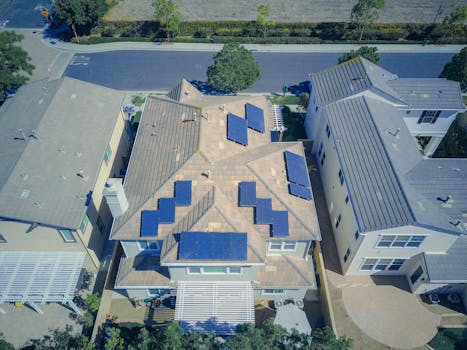“Unlock Savings: Essential Insights on Solar Inverter Installation Costs.”
When considering the installation of a solar inverter, understanding the associated costs is crucial for budgeting and planning your solar energy system. Solar inverters, which convert the direct current (DC) generated by solar panels into alternating current (AC) for use in homes and businesses, are a vital component of any solar setup. Installation costs can vary significantly based on factors such as the type of inverter, system size, installation complexity, and regional labor rates. Additionally, potential incentives and rebates can influence the overall expense. This guide will provide essential insights into the factors affecting solar inverter installation costs, helping you make informed decisions for your solar energy investment.
Factors Influencing Solar Inverter Installation Costs
When considering the installation of a solar inverter, understanding the various factors that influence costs is essential for making an informed decision. The price of solar inverter installation can vary significantly based on several key elements, each contributing to the overall expenditure. One of the primary factors is the type of inverter selected. There are several types available, including string inverters, microinverters, and power optimizers, each with its own price point and efficiency levels. String inverters are generally the most affordable option, but they may not perform as well in shaded conditions compared to microinverters, which tend to be more expensive but offer enhanced performance and monitoring capabilities.
Another critical factor is the size of the solar system being installed. Larger systems typically require more powerful inverters, which can increase the overall cost. Additionally, the complexity of the installation can also play a significant role in determining expenses. For instance, if the installation site has challenging roof angles or requires extensive electrical work, labor costs may rise accordingly. Furthermore, the geographical location of the installation can influence costs due to variations in labor rates and permitting fees across different regions.
Permitting and inspection fees are often overlooked but can add to the total installation cost. Local regulations may require specific permits for solar installations, and these can vary widely depending on the municipality. It is essential to factor in these potential costs when budgeting for a solar inverter installation. Moreover, the availability of incentives and rebates can also impact the overall financial picture. Many states and local governments offer financial incentives for solar installations, which can help offset some of the initial costs. Therefore, it is advisable to research available programs in your area to take full advantage of potential savings.
The quality of the components used in the installation is another significant factor that can influence costs. Higher-quality inverters may come with a higher upfront price but often provide better warranties and longer lifespans, ultimately leading to lower maintenance costs over time. Investing in a reputable brand can also ensure better performance and reliability, which is crucial for maximizing the return on investment in solar technology.
Additionally, the experience and reputation of the installation company can affect pricing. Established companies with a proven track record may charge more for their services, but they often provide superior workmanship and customer support. It is essential to weigh the potential benefits of hiring a reputable installer against the cost savings of choosing a less experienced contractor.
Lastly, market conditions can also play a role in determining installation costs. Fluctuations in the prices of raw materials, such as silicon for solar panels and metals for inverters, can lead to changes in overall pricing. As demand for solar technology continues to grow, it is crucial to stay informed about market trends that may impact costs.
In conclusion, understanding the various factors influencing solar inverter installation costs is vital for anyone considering this investment. By carefully evaluating the type of inverter, system size, installation complexity, permitting requirements, available incentives, component quality, installer reputation, and market conditions, homeowners can make informed decisions that align with their financial goals and energy needs. This comprehensive approach not only helps in budgeting effectively but also ensures a successful transition to solar energy.
Average Costs of Different Types of Solar Inverters
When considering the installation of solar energy systems, understanding the average costs associated with different types of solar inverters is crucial for homeowners and businesses alike. Solar inverters play a vital role in converting the direct current (DC) generated by solar panels into alternating current (AC), which is necessary for powering household appliances and feeding energy back into the grid. The type of inverter selected can significantly influence both the initial investment and the long-term efficiency of a solar energy system.
There are primarily three types of solar inverters: string inverters, microinverters, and power optimizers. Each type comes with its own set of advantages and costs. String inverters are the most common and typically the most affordable option. On average, the cost of a string inverter ranges from $1,000 to $3,000, depending on the size and brand. These inverters are designed to connect multiple solar panels in a series, which makes them a cost-effective choice for many residential installations. However, it is important to note that the performance of string inverters can be affected by shading or orientation issues, as the output of the entire string is limited by the least productive panel.
In contrast, microinverters offer a more advanced solution, allowing each solar panel to operate independently. This can lead to increased energy production, especially in situations where panels may be partially shaded or installed at different angles. The average cost of microinverters typically ranges from $1,500 to $3,500 for a system that includes multiple units. While the initial investment is higher than that of string inverters, the potential for increased energy yield can make microinverters a worthwhile consideration for homeowners looking to maximize their solar energy production.
Power optimizers represent a hybrid solution, combining elements of both string inverters and microinverters. These devices are installed on each solar panel and work to optimize the energy output before sending it to a central string inverter. The average cost for power optimizers generally falls between $1,200 and $3,000, depending on the number of panels and the specific technology used. This option can provide some of the benefits of microinverters while still maintaining a centralized inverter system, making it an appealing choice for those who want to balance cost and performance.
In addition to the type of inverter, several factors can influence the overall installation costs. For instance, the size of the solar energy system, the complexity of the installation, and any additional equipment required, such as monitoring systems or battery storage, can all contribute to the final price. Furthermore, labor costs can vary significantly based on geographic location and the experience of the installation team. Therefore, it is advisable for potential solar energy users to obtain multiple quotes from reputable installers to ensure they are getting a fair price.
Ultimately, understanding the average costs associated with different types of solar inverters is essential for making informed decisions about solar energy investments. By weighing the initial costs against the potential long-term benefits, homeowners and businesses can choose the inverter type that best aligns with their energy needs and financial goals. As the solar industry continues to evolve, staying informed about technological advancements and pricing trends will empower consumers to make choices that enhance their energy independence and sustainability.
Hidden Costs in Solar Inverter Installation
When considering the installation of a solar inverter, many homeowners focus primarily on the upfront costs associated with purchasing the inverter itself and the installation labor. However, it is crucial to recognize that hidden costs can significantly impact the overall financial picture of a solar energy system. Understanding these hidden costs can help you make a more informed decision and avoid unexpected expenses down the line.
One of the most common hidden costs in solar inverter installation is related to the electrical upgrades that may be necessary to accommodate the new system. Older homes, in particular, may not have the electrical infrastructure required to support modern solar technology. This could involve upgrading the electrical panel, which can range from a few hundred to several thousand dollars, depending on the extent of the work needed. Additionally, if your home’s wiring is outdated or insufficient, further electrical work may be required, adding to the overall cost.
Another often-overlooked expense is the cost of permits and inspections. Local regulations typically require permits for solar installations, and these can vary significantly from one municipality to another. The fees for these permits can add up, and in some cases, additional inspections may be mandated, further increasing costs. It is essential to factor in these potential expenses when budgeting for your solar inverter installation.
Moreover, the choice of inverter type can also influence hidden costs. While string inverters are generally less expensive upfront, they may not be the most efficient option for every installation. In contrast, microinverters or power optimizers, while initially more costly, can provide better performance in certain scenarios, particularly in shaded areas. Therefore, it is vital to consider not only the initial purchase price but also the long-term performance and potential savings associated with different inverter types.
In addition to these factors, maintenance and warranty considerations can also contribute to hidden costs. While many solar inverters come with warranties, these warranties may not cover all potential issues. For instance, if the inverter fails outside of the warranty period, replacement costs can be substantial. Furthermore, regular maintenance is necessary to ensure optimal performance, and while this may not be a significant expense annually, it is still an important factor to consider in the long-term financial planning of your solar system.
Another hidden cost that often goes unnoticed is the potential need for additional equipment, such as monitoring systems or battery storage. While these components can enhance the efficiency and reliability of your solar energy system, they also add to the initial investment. Homeowners should carefully evaluate their energy needs and consider whether these additional features are necessary or beneficial for their specific situation.
Lastly, it is essential to consider the potential impact of energy policy changes and incentives. While many regions offer tax credits or rebates for solar installations, these incentives can change over time. If you are relying on these financial benefits to offset your installation costs, it is wise to stay informed about any changes in local or federal policies that could affect your overall investment.
In conclusion, while the initial costs of solar inverter installation may seem straightforward, a variety of hidden costs can arise that significantly affect the total expenditure. By being aware of these potential expenses, including electrical upgrades, permits, maintenance, and additional equipment, homeowners can better prepare for the financial commitment of transitioning to solar energy. Ultimately, a thorough understanding of all associated costs will lead to a more successful and satisfying solar investment.
Financial Incentives and Rebates for Solar Inverter Installation
When considering the installation of solar inverters, understanding the financial incentives and rebates available can significantly impact the overall cost and return on investment. Governments and various organizations often provide these incentives to encourage the adoption of renewable energy sources, making solar energy more accessible to homeowners and businesses alike. As you delve into the specifics of solar inverter installation costs, it is essential to recognize the various financial benefits that can alleviate the initial expenditure.
One of the most prominent incentives available is the federal solar tax credit, also known as the Investment Tax Credit (ITC). This program allows homeowners to deduct a substantial percentage of the cost of their solar system, including the inverter, from their federal taxes. As of 2023, this credit stands at 30%, which can translate into significant savings. For instance, if the total cost of your solar installation is $20,000, you could potentially reduce your tax liability by $6,000. This incentive not only lowers the upfront cost but also enhances the overall financial viability of solar energy systems.
In addition to federal incentives, many states offer their own rebates and tax credits, which can further reduce the financial burden of solar inverter installation. These state-level programs vary widely in terms of availability and amount, so it is crucial to research the specific incentives in your area. Some states provide cash rebates based on the size of the solar system, while others may offer property tax exemptions for solar installations. By taking advantage of these local incentives, homeowners can maximize their savings and make solar energy a more attractive option.
Moreover, utility companies often have programs designed to promote renewable energy adoption. These programs may include rebates for solar inverter installation or performance-based incentives that reward homeowners for the energy their systems produce. By participating in these utility programs, you can not only reduce your installation costs but also benefit from ongoing financial rewards as your solar system generates electricity. It is advisable to contact your local utility provider to inquire about any available incentives that could complement your solar investment.
Another financial consideration is the availability of financing options specifically tailored for solar installations. Many financial institutions now offer loans with favorable terms for solar projects, allowing homeowners to spread the cost of their solar inverter installation over time. These loans often come with low-interest rates and flexible repayment plans, making it easier for individuals to invest in solar energy without a significant upfront payment. Additionally, some states and local governments provide low-interest loans or grants to further support solar adoption, making it essential to explore all available financing avenues.
As you navigate the landscape of solar inverter installation costs, it is crucial to stay informed about the evolving incentives and rebates. These financial benefits can significantly influence your decision to invest in solar energy, ultimately leading to substantial long-term savings. By leveraging federal, state, and utility incentives, as well as exploring financing options, you can make a well-informed choice that aligns with your financial goals while contributing to a more sustainable future. In conclusion, understanding the financial incentives and rebates available for solar inverter installation is not just beneficial; it is a vital component of making a sound investment in renewable energy.
Q&A
1. **What is the average cost of solar inverter installation?**
The average cost of solar inverter installation typically ranges from $1,000 to $3,000, depending on the type and size of the inverter.
2. **What factors influence the installation cost of solar inverters?**
Factors include the type of inverter (string, micro, or hybrid), system size, installation complexity, labor costs, and any additional equipment needed.
3. **Are there any additional costs associated with solar inverter installation?**
Yes, additional costs may include permits, inspections, electrical upgrades, and potential maintenance or warranty fees.
4. **Can I expect any financial incentives for installing a solar inverter?**
Yes, many regions offer tax credits, rebates, or financing options that can help offset the installation costs of solar inverters.
Conclusion
The cost of solar inverter installation can vary significantly based on factors such as the type of inverter, system size, installation complexity, and regional labor rates. On average, homeowners can expect to pay between $1,000 to $3,000 for inverter installation, not including the cost of the solar panels themselves. It’s essential to consider additional expenses such as permits, inspections, and potential upgrades to electrical systems. To ensure a successful installation, obtaining multiple quotes from qualified installers and understanding the warranty and maintenance options is crucial. Overall, while the initial investment may seem high, the long-term savings on energy bills and potential tax incentives can make solar inverter installation a financially sound decision.




